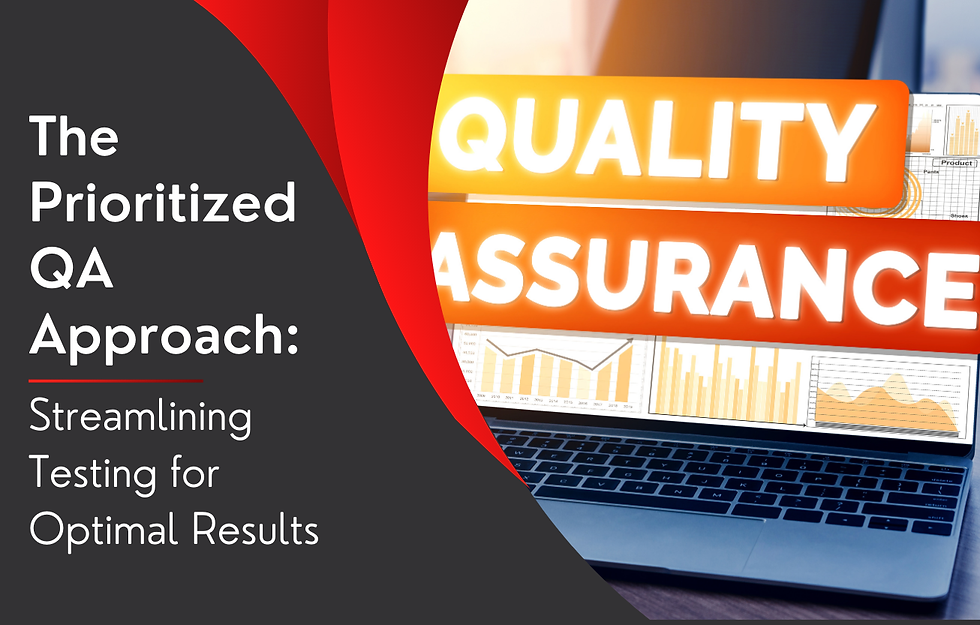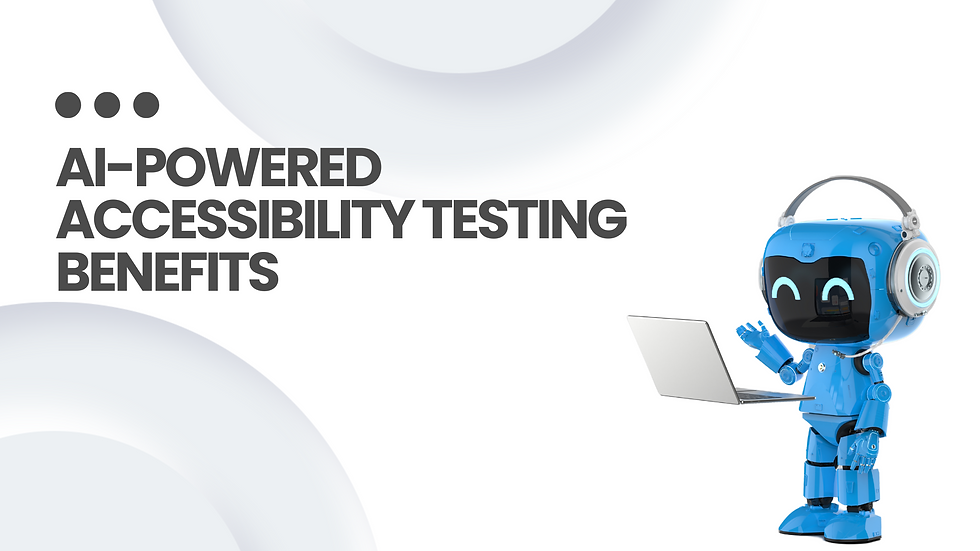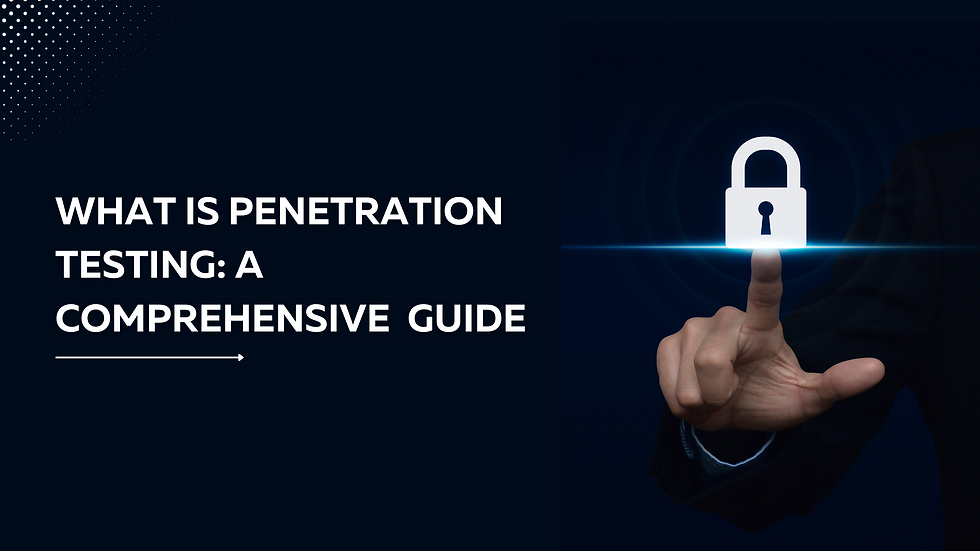The Prioritized QA Approach: Streamlining Testing for Optimal Results
- bugraptorsanalytic
- Mar 26
- 5 min read

The ever-growing software development sector maintains high-quality product creation as its fundamental necessity. The rise of software complexity and shorter release schedules makes it essential to determine how you can create successful and efficient QA testing operations. Prioritization is essential. A deliberate strategy is essential because an unscheduled QA services workload leads to delayed schedules and inferior quality outcomes.
This article looks into the critical approaches for prioritizing your QA efforts, ensuring you focus on what is genuinely important. We'll look at practical recommendations to help you tame the testing beast and produce outstanding products.
Understanding the Importance of Prioritization
Before we go into key strategies, let's discuss why prioritizing is so important. Effective QA solutions focus on testing the correct things at the right time, rather than testing everything. The efficacy of QA testing solutions is dependent on correct resource distribution to produce the best outcomes. Here's why prioritization is important:
Resource Optimization: Prioritization ensures that your QA testing solutions are focused on your software's most critical areas. This avoids wasted effort in low-impact areas, allowing you to make the most use of your resources and team members' time.
Risk Mitigation: Your tests of high-risk features conducted at an early stage enable the effective reduction of serious manufacturing issues. The approach protects your software from integrity-related threats in advance.
Accelerated Time-to-Market: Efficient prioritization streamlines the testing process. Your product development speed can increase through concentrated testing efforts for critical test cases, which maintains quality standards.
Enhanced User Satisfaction: The procedure of testing critical features first results in highly reliable products that provide users with excellent functionality and usability.
Improved ROI of QA Solutions: Investing QA solutions exclusively into the software's essential areas gives you the maximum return on investment.
Key Strategies for Prioritizing QA Efforts
Effective prioritization is the cornerstone of successful QA services. To ensure your QA testing efforts are targeted and impactful, a strategic approach is essential. Here's a breakdown of key strategies:
Risk-Based Testing:
Determine high-risk locations based on variables such as complexity, criticality, and possible effect.
Increase the amount of resources dedicated to thorough testing in these areas.
Core functionality, such as payment gateways and user authentication, should take primacy.
This means that you will focus more of your QA services on these areas.
Requirement Prioritization:
Work with both product owners and stakeholders to establish requirement priorities based on business value needs alongside user needs.
Ace test activities by concentrating testing on features that grant maximum benefit to end users.
Create requirements types through the MoSCoW (Must have, Should have, Could have, Won't have) classification system.
Test Case Prioritization:
Classify test cases according to their criticality and frequency of application.
Prioritize test cases for essential functions and high-risk scenarios.
Use test case management tools to monitor and prioritize test cases efficiently.
Leveraging Automation Testing:
Find manual test cases which perform repeatedly and consume extensive time to automate them.
Using automation testing frameworks will enhance both testing efficiency and coverage levels.
The testing automation efforts should concentrate on regression tests along with core functionalities.
Consider how the latest AI trends in software testing can be integrated into your automation testing strategy.
Manual Testing for Exploratory and Usability Testing:
Recognize the value of manual testing for exploratory testing, usability testing, and identifying edge cases.
Use skilled testers to perform ad-hoc testing and uncover hidden defects.
Prioritize manual testing for user interface and user experience (UI/UX) testing.
Data-Driven Prioritization:
Utilize metrics and analytics to track testing progress and identify bottlenecks.
Analyze defect data to identify patterns and trends.
Use data to inform prioritization decisions and improve testing strategies.
This is a large benefit of many modern QA solutions.
Continuous Integration and Continuous Delivery (CI/CD) Integration:
Testing operations need integration into the Continuous Integration and Continuous Delivery pipeline to receive continuous feedback supporting rapid development cycles.
Testing automation should run throughout the entire development process schedule.
Your testing needs automated tests with brief feedback capabilities on updated code.
Feedback Loops:
Set up high-quality feedback systems that allow developers and product owners to share feedback with end-users.
The early testing phases need feedback collection to discover and solve problems quickly.
You should exploit bug-tracking software to track and organize defects according to priority.
Regular Review and Adjustment:
Measure your testing strategy using regular reviews and analyze this with changing requirements along with priorities.
The team should perform retrospectives to discover opportunities for improvement.
The project demands flexibility with your approach and swift reactions to changing requirements.
Implementing Effective Prioritization
Structuring efforts together with coordination are necessary for turning strategic decision prioritization into practical achievements. Making priorities requires active integration into the daily work process rather than just defining targets. To achieve impactful QA solutions from your prioritization work, you must apply the following approach:
Establish a Clear Framework: Deploy the risk-based approach which the provided code illustrates to assess and order features through numeric values. The scoring process for complex features and critical components and their potential effects allows for a priority list development through data analysis. Your test efforts will focus specifically on high-risk areas because of this methodology.
Foster Collaboration and Communication: The process of setting priority requirements demands perfect coordination between developers, testers, and product owners. A system of regular meetings along with feedback systems helps different team members stay in agreement on their common objectives. The tracking management and communication of priorities can be achieved through Jira or comparable platforms.
Leverage Testing Tools and Automation: Testing software tools should be used to analyze test cases alongside defects and monitor current status. Your manual testers should focus on essential difficult cases during automated testing sessions through framework implementation. The execution result displays the system which enables task order selection.
Iterative Refinement and Data Analysis: Prioritization is not static. Repeat analyses of testing effort data help your team refine their approach by studying defect reports with test coverage statistics. The organization should perform regular assessment and modification of priority levels while considering changing requirements and new emerging risks.
By adopting these strategies and best practices, you can effectively prioritize your QA services, maximize resources, and deliver high-quality software that meets your business goals.
Concluding Thoughts
Excellence in software delivery depends on mastering how to organize QA testing within the current fast-moving development framework. Your QA services will reach peak optimization by deploying risk-based strategies along with requirement priority sorting and strategic usage of automation testing with essential manual testing.
Regular assessments and feedback systems alongside data-based decisions maintain the alignment of your QA solutions to changing project requirements. The process of prioritization should continue over time because it allows you to allocate your resources to develop software that results in elevated user satisfaction and business achievements.










Comments